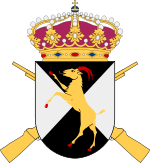Hälsingland Regiment
| Hälsingland Regiment | |
|---|---|
|
Hälsinge regemente (I 14, I 14/Fo 49, I 14/Fo 21) | |
|
Insignia | |
| Active | 1630–1997 |
| Country |
|
| Branch | Swedish Army |
| Type | Infantry |
| Size | Regiment |
| Motto(s) | "Fasthet, Förmåga, Förtroende" ("Solidity, Ability, Confidence") |
| Colours | Black and white |
| March | "Marcia militaris" (late 19th century–1997) |
| Battle honours | Novgorod (1611), Warszawa (1656), Fredriksodde (1657), Tåget över Bält (1658), Lund (1676), Landskrona (1677), Narva (1700), Düna (1701), Jakobstadt (1704), Gemäuerthof (1705), Gadebusch (1712) |
The Hälsingland Regiment (Swedish: Hälsinge regemente), designations I 14, I 14/Fo 49 and I 14/Fo 21, was a Swedish Army infantry regiment that traced its origins back to the 16th century. It was disbanded in 1997. The regiment's soldiers were originally recruited from the provinces of Hälsingland and Gästrikland, and it was later garrisoned in Gästrikland.
History
The regiment has its origins in fänikor (companies) raised in Hälsingland and Gästrikland in the 1550s and 1560s. In 1615, these units—along with fänikor from the nearby provinces of Medelpad, Ångermanland and Västerbotten—were organised by Gustav II Adolf into Norrlands storregemente, of which eleven of the total 24 companies were recruited in Hälsingland and Gästrikland. Norrlands storregemente consisted of three field regiments, of which Hälsinge regemente was one. Sometime around 1624, the grand regiment was permanently split into three smaller regiments, of which Hälsinge regemente was one.
The regiment was officially raised in 1630 although it had existed since 1624. Hälsinge regemente was one of the original 20 Swedish infantry regiments mentioned in the Swedish constitution of 1634. The regiment was also called Joakim Brahes regemente after its first commander Joakim Brahe. It was allotted in 1682 as the second Swedish regiment to be so, after Dalregementet.
The regiment was given the designation I 14 (14th Infantry Regiment) in a general order in 1816. Hälsinge regemente was garrisoned in Gävle from 1909. In 1973, the regiment gained the new designation I 14/Fo 49 as a consequence of a merge with the local defence area Fo 49. When the local defence area changed designation to Fo 21 in 1982, the designation changed to I 14/Fo 21. The regiment was disbanded in 1997, and the barracks that had been refurbished in 1995–1996 were turned into a college campus for the University College of Gävle.
Campaigns
- The Swedish War of Liberation (1521–1523)[1]
- The Northern Seven Years' War (1563–1570)[1]
- The War against Russia (1590–1595)[1]
- The Polish War (1600–1629)
- The Thirty Years' War (1630–1648)
- The Torstenson War (1643–1645)
- The Northern Wars (1655–1661)
- The Scanian War (1674–1679)
- The Great Northern War (1700–1721)
- The Hats' Russian War (1741–1743)
- The Seven Years' War (1757–1762)
- The Gustav III's Russian War (1788–1790)
- The Finnish War (1808–1809)
- The Campaign against Norway (1814)
Organisation
|
|
Commanders
Regimental commanders active from 1630 to 1997:
|
|
Name, designation and garrison
| Name | Translation | From | To | |
|---|---|---|---|---|
| Joakim Brahes regemente | Joakim Brahe's Regiment | 1630 | – | 1634 |
| Hälsinge regemente | Hälsingland Regiment | 1633 | – | 31 December 1997 |
| Designation | From | To | |
|---|---|---|---|
| I 14 | 1816 | – | 30 June 1973 |
| I 14/Fo 49 | 1 July 1973 | – | 30 June 1982 |
| I 14/Fo 21 | 1 July 1982 | – | 31 December 1997 |
| Training ground or garrison town | From | To | |
|---|---|---|---|
| Florhed | 1630 | – | 1689 |
| Mohed | 1689 | – | 14 February 1909 |
| Gävle (G) | 15 February 1909 | – | 31 December 1997 |
See also
References
- Braunstein, Christian (2003). Sveriges arméförband under 1900-talet. Stockholm: Statens Försvarshistoriska Museer. ISBN 91-971584-4-5.
- Holmberg, Björn (1993). Arméns regementen, skolor och staber: en sammanställning. Arvidsjaur: Svenskt militärhistoriskt bibliotek. ISBN 91-972209-0-6.
- Kjellander, Rune (2003). Sveriges regementschefer 1700-2000: chefsbiografier och förbandsöversikter. Stockholm: Probus. ISBN 91-87184-74-5.
- Nelsson, Bertil (1993). Från Brunkeberg till Nordanvind: 500 år med svenskt infanteri. Stockholm: Probus. ISBN 91-87184-23-0.
- Svensk rikskalender 1908. Stockholm: P.A. Norstedt & Söner. 1908.
- Online
- Holmén, Pelle; Sjöberg, Jan (2007). "Swedish Armed Forces 1900-2000". Archived from the original on September 28, 2007. Retrieved 2007-08-20.
- Högman, Hans (2007). "Militaria - Svensk militärhistoria". Retrieved 2007-08-20.
- Persson, Mats (1998). "Swedish Army Regiments". Archived from the original on 2007-08-30. Retrieved 2007-08-20.
- Sharman, Ken (2000). "Swedish military administrative division as per 1629". Retrieved 2007-08-20.
Notes
Coordinates: 60°40′08″N 17°07′11″E / 60.66889°N 17.11972°E

